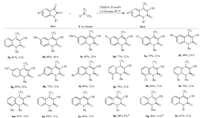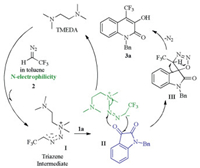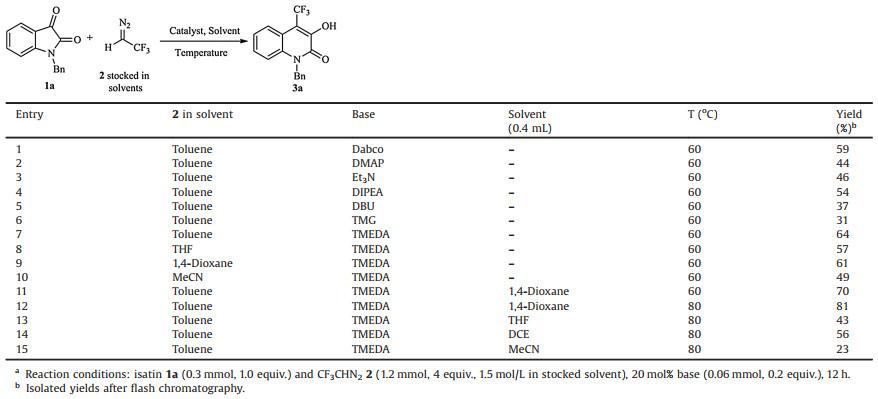b Institute of Medicinal Plant Development, Chinese Academy of Medical Science & Peking Union Medical College Beijing 100193, China
Quinolinone derivatives have received a great deal of interest in medicinal, bioorganic, and industrial chemistry due to as key privileged scaffolds widely existed in many important biologically active molecules, agrochemicals and pharmaceuticals (Fig. 1) [1]. Trifluoromethyl (CF3)-containing quinolinone represents as one of the attractive heterocycles because embedding CF3 moiety could extraordinarily affect their physiochemical, biological, and pharmacological properties [2]. Therefore, the development of new protocols to construct such heterocycles persists as an important goal in medicinal and organic chemistry. Known methods for the synthesis of 4-trifluoromethyl quinolinones involve the condensation of anilines with ethyl 4, 4, 4-trifluoroacetoacetate [3]. However, these methods suffer from prefunctionalized starting materials and poor regioselectivities. In this context, the development of the efficient methodologies for the synthesis of trifluoromethylated quinolinones is highly desirable in synthetic and medicinal chemistry.

|
Download:
|
| Fig. 1. Selected bioactive molecules containing quinolinone scaffold. | |
Recently, 2, 2, 2-trifluorodiazoethane (CF3CHN2) has emerged as an attractive fluorine-containing building block based on its different reactivities such as metal carbene precursors, 1, 3-dipoles, C-nucleophiles/electrophiles and N-terminal electrophiles [4]. Compelling works have been reported according to these roles, especially ring formation protocols by [2 + 1] cycloaddition and [3 + 2] cycloaddition. Since the pioneering work for trifluoromethyl cyclopropanes and cyclopropenes synthesis via [2 + 1] cycloaddition by Carreira group [5], more methods by various catalytic strategy (Fe [4c, 6], Cu [7], Rh [4c, 8], Ru [9], Co [4d], and myoglobin12 [10]) for trifluoromethylated three-membered rings symmetric and asymmetric synthesis have been promoted [5]. Also, versatile protocols for trifluoromethylated five-membered heterocycles synthesis, such as pyrazoles, pyrazolines, 1, 2, 3-triazoles, and tetrazoles, was established by [3 + 2] cycloaddition [4j, 11]. Despite huge advances in the trifluoromethylated three-and five-membered ring synthesis, to some extent, these transformations are confined to the cycloaddition reactions. The trifluoromethylated six-membered heterocycles formation via ring expansion using CF3CHN2 as a CF3 synthon still remains rarely exploited.
Reported work indicated that the quinolinone ring could be assemble by ring expansion reaction of isatin with diazomethane and Eistert ring expansion of isatin with ethyl diazocetate [12-14]. We have reported the combination of CF3CHN2 with Lewis base could make sense in organic synthesis and medicinal chemistry via triazene intermediates formation [15]. Herein, as part of our ongoing research, we demonstrate an efficient and facile ring expansion of isatin with CF3CHN2 catalyzed by Lewis base to assemble 3-hydroxy-4-(trifluoromethyl) quinolinones with high efficiency (Scheme 1).

|
Download:
|
| Scheme 1. Lewis base catalyzed ring expansion reactions. | |
The plan study began with an evaluation of Lewis base in the model reactions of isatin 1a with CF3CHN2 2 in toluene at 60 ℃. Notably, the reaction proceeded smoothly and yielded the desired ring expansion product in moderate yield with Dabco as the catalyst (Table 1, entry 1). Next, we evaluated different Lewis bases (entries 2–7). Interestingly, we found that the TMEDA afforded an efficient reaction (64%) (entry 7). To improve the yield of 3a, various stock solvents of CF3CHN2 were examined to indicate that toluene was still essential for the high efficiency of this ring expansion protocol (entry 8–10). Further optimization of this transformation revealed that the external solvent 1, 4-dioxane could significantly enhance the reaction efficiency (entries 11 and 13–15). Attempts to increase the yield of 3a were carried out with different reaction temperatures. Notably, this reaction afforded the trifluoromethylated quinolinone heterocycle with excellent yield at 80 ℃ (entry 12).
|
|
Table 1 Condition optimization. a |
With the optimized conditions in hand, we attempted to explore the generality of this ring expansion protocol to construct a range of substituted 3-hydroxy-4-(trifluoromethyl)quinolinones. As indicated in Scheme 2, a number of substituted isatins 1 were suitable for this transformation. Various substrates with both electron-rich (1b, 1c) and electron-deficient (1d-f) substituents at 5-position of isatin scaffold were tolerated, yielding the corresponding quinolinones in very good to excellent yields. The trifluoromethoxy substrates 1g formed the desired product in excellent yield under the standard conditions, thus affording an efficient route to multiple trifluoromethylated compound. Notably, the halogen substituted substrates at different positions were all suitable for the transformation with high efficiency (3h-l). Furthermore, this Lewis base-catalyzed ring expansion reaction was extended by variation of the N-substituent R1 of the isatin 1, resulting in the construction of the corresponding trifluoromethy-lated products 3n, 3o in excellent yields (R1 = Me, Ph) and 3p, 3q in poor yields (R1 = Ac, Boc). Also, unprotected isatin was also suitable for this transformation and assembled 3r with high efficiency. However, the iodine incorporated poly-substituted at 4, 7-position of isatin could be employed for this protocol without forming the ring-expansion product but affording the spiro-epoxyoxindole product 3s in 46% yield and leaving an additional iodine group for further transformation (Scheme 3).

|
Download:
|
| Scheme 2. Scope of substrates. Reaction conditions: 1 (0.3 mmol, 1.0 equiv.) and CF3CHN (1.2 mmol, 4 equiv., 1.5 mol/L in toluene), 20 mol% TMEDA (0.06 mmol, 0.2 equiv.), 1, 4-dioxane (0.4 mL), 80 C, 12 36 h. a produced 3 r with 31% yield. b produced 3 r with 37% yield. | |

|
Download:
|
| Scheme 3. CF-containing spiro-epoxyoxindole synthesis. | |
To further show the generality of the ring expansion procedure, we performed the reaction of alkyne protected isatin 1t with CF3CHN2 in toluene under the standard conditions. This Lewis base catalytical strategy unlocked new routes for the straightforward and efficient assembly of 3-trifluormethylpyra-zole fused 3-hydroxy-4-(trifluoromethyl) quinolinone (Scheme 4). The configurations of compounds 3t was structurally confirmed by X-ray diffraction analysis and the supplementary crystallographic data can be obtained free of charge from the Cambridge Crystallographic Data Centre (CCDC No. 1886034).

|
Download:
|
| Scheme 4. 3-Trifluormethylpyrazole fused quinolinone synthesis. | |
A postulated mechanism for this Lewis base catalysis via the triazene intermediate is proposed based on our previous work and literature precedents (Scheme 5) [15]. Firstly, triazene intermediate I is generated from the N-electrophilicity of CF3CHN2 with TMEDA. Then, this intermediate undergoes the [3 + 2] cycloaddition with isatin 1a to regenerate catalyst and afford spiroheterocycle intermediate III. The subsequent ring expansion step takes place to generate the final product 3a with loss of nitrogen gas at high temperature.

|
Download:
|
| Scheme 5. Proposed mechanism for ring expansion reactions. | |
In conclusion, we have developed a Lewis base catalyzed ring expansion of isatins with CF3CHN2 via triazene formation procedure to synthesize a series of 3-hydroxy-4-(trifluoro-methyl)quinolinones in very good to excellent yields. Notably, this ring expansion strategy also allows the synthesis of the 3-trifluormethylpyrazole fused 3-hydroxy-4-(trifluoromethyl) quinolinone. Further applications of Lewis base catalysis with CF3CHN2 for the synthesis of related heterocycles will be reported in due course.
Declaration of competing interestThe authors declare no competing financial interest.
AcknowledgmentsWe are grateful for financial support from the National Natural Science Foundation of China (No. 81602977), the CAMS Innovation Fund for Medical Sciences (Nos. 2019-RC-HL-010, 2017-I2M-1-013), the Science and Technology Development Project of Jilin Province of China (No. 20190304050YY) and China Association of Chinese Medicine (No. 2017QNRC001).
Appendix A. Supplementary dataSupplementary material related to this article can be found, in the online version, at doi:https://doi.org/10.1016/j.cclet.2019.11.027.
| [1] |
(a) S.Y. Sit, F.J. Ehrgott, J. Gao, N.A. Meanwell, Bioorg. Med. Chem. Lett. 6 (1996) 499-504; (b) A.Heguy, P.Cai, P.Meyn, etal., AntiviralChem.Chemother.9 (1998)149-155; (c) Y. Aoki, M. Ishiwara, A. Koda, H. Takagaki, Eur. J. Pharmacol. 409 (2000) 325-330; (d)P.R.Angibaud, M.G.Venet, W.Filliers, etal., Eur.J.Org.Chem.3 (2004)479-486; (e) S. Grabley, J. Cai, M. Meiners, et al., J. Nat. Prod. 68 (2005) 1397-1399; (f) P. Cheng, Q. Zhang, Y.B. Ma, et al., Bioorg. Med. Chem. Lett. 18 (2008) 3787-3789; (g) A. Maiti, P. Reddy, M. Sturdy, et al., J. Med. Chem. 52 (2009) 1873-1884; (h) A.J. Duplantier, S.L. Becker, M.J. Bohanon, et al., J. Med. Chem. 52 (2009) 3576-3585; (i) V. Suchaud, F. Bailly, C. Lion, et al., Bioorg. Med. Chem. Lett. 22 (2012) 3988-3992; (j) Y.C. Yuan, R. Yang, D. Zhang-Negrerie, et al., J. Org. Chem. 78 (2013) 5385-5392. |
| [2] |
(a) V. Pliska, B. Testa, H. Waterbeemd, Lipophilicity in Drug Action and Toxicology, Wiley-VCH, Weinheim, 2008; (b) O. Lefebvre, M. Marull, M. Schlosser, Eur. J. Org. Chem. (2003) 2115-2121; (c) M. Marull, O. Lefebvre, M. Schlosser, Eur. J. Org. Chem. (2004) 54-63. |
| [3] |
(a) F. Leroux, O. Lefebvre, M. Schlosser, Eur. J. Org. Chem. (2006) 3147-3151; (b) M. Marull, M. Schlosser, Eur. J. Org. Chem. 2003 (2003) 1576-1588; (c) D.O. Berbasov, V.A. Soloshonok, Synthesis 13 (2003) 2005-2010. |
| [4] |
(a) P.K. Mykhailiuk, S. Afonin, G.V. Palamarchuk, et al., Angew. Chem. Int. Ed. 47 (2008) 5765-5767; (b) B. Morandi, E.M. Carreira, Angew. Chem. Int. Ed. 49 (2010) 938-941; (c) B. Morandi, E.M. Carreira, Angew. Chem. Int. Ed. 49 (2010) 4294-4296; (d) B. Morandi, B. Mariampillai, E.M. Carreira, Angew. Chem. Int. Ed. 50 (2011) 1101-1104; (e) C.B. Liu, W. Meng, F. Li, et al., Angew. Chem. Int. Ed. 51 (2012) 6227-6230; (f) O.A. Argintaru, D. Ryu, I. Aron, G.A. Molander, Angew. Chem. Int. Ed. 52 (2013) 13656-13660; (g) G.A. Molander, D. Ryu, Angew. Chem. Int. Ed. 53 (2014) 14181-14185; (h) R. Guo, Y. Zheng, J.A. Ma, Org. Lett. 18 (2016) 4170-4173; (i) H. Luo, G. Wu, Y. Zhang, J. Wang, Angew. Chem. Int. Ed. 54 (2015) 14503-14507; (j) S. Hyde, J. Veliks, B. Liégault, et al., Angew. Chem. Int. Ed. 55 (2016) 3785-3789; (k) A.V. Arkhipov, V.V. Arkhipov, J. Cossy, V.O. Kovtunenko, P.K. Mykhailiuk, Org. Lett. 18 (2016) 3406-3409; (l) A. Tinoco, V. Steck, V. Tyagi, R. Fasan, et al., J. Am. Chem. Soc. 139 (2017) 5293-5296; (m) Z. Chen, Y. Zheng, J.A. Ma, Angew. Chem. Int. Ed. 56 (2017) 4569-4574; (n) X.Y. Zhang, Z.H. Liu, X.Y. Yang, et al., Nat. Commun. 10 (2019) 284; (o) Z.F. Wang, A.G. Herraiz, A.M. del Hoyo, M.G. Suero, Nature 554 (2018) 86-91. |
| [5] |
B. Morandi, J. Cheang, E.M. Carreira, Org. Lett. 13 (2011) 3080-3081. DOI:10.1021/ol200983s |
| [6] |
S. Li, W.J. Cao, J.A. Ma, Synlett 28 (2017) 673-678. |
| [7] |
O.S. Artamonov, E.Y. Slobodyanyuk, D.M. Volochnyuk, et al., Eur. J. Org. Chem. (2014) 3592-3598. DOI:10.1002/ejoc.201402158 |
| [8] |
(a) O. Artamonov, P. Mykhailiuk, N. Voievoda, D. Volochnyuk, I. Komarov, Synthesis 3 (2010) 443-446; (b) D. Gladow, H.U. Reissig, Helv. Chim. Acta 95 (2012) 1818-1830. |
| [9] |
M. Kotozaki, S. Chanthamath, T. Fujii, K. Shibatomi, S. Iwasa, Chem. Commun. 54 (2018) 5110-5113. DOI:10.1039/C8CC02286K |
| [10] |
A. Tinoco, V. Steck, V. Tyagi, R. Fasan, J. Am. Chem. Soc. 139 (2017) 5293-5296. DOI:10.1021/jacs.7b00768 |
| [11] |
(a) F. Li, J. Nie, L. Sun, Y. Zheng, J.A. Ma, Angew. Chem. Int. Ed. 52 (2013) 6255-6258; (b) S. Wang, L.J. Yang, J.L. Zeng, Y. Zheng, J.A. Ma, Org. Chem. Front. 2 (2015) 1468-1474; (c) J. Britton, T.F. Jamison, Angew. Chem. Int. Ed. 56 (2017) 8823-8827; (d) Z. Chen, S.Q. Fan, Y. Zheng, J.A. Ma, Chem. Commun. 51 (2015) 16545-16548. |
| [12] |
A. Gioiello, F. Venturoni, M. Marinozzi, B. Natalini, R. Pellicciari, J. Org. Chem. 76 (2011) 7431-7437. DOI:10.1021/jo201205u |
| [13] |
R. Paterna, V. André, M.T. Duarte, et al., Eur. J. Org. Chem. 2013 (2013) 6280-6290. DOI:10.1002/ejoc.201300796 |
| [14] |
Y. Tangella, K.L. Manasa, N.H. Krishna, Org. Lett. 20 (2018) 3639-3642. DOI:10.1021/acs.orglett.8b01417 |
| [15] |
S. Lv, H. Zhou, X. Yu, et al., Commun. Chem. 2 (2019) 69. DOI:10.1038/s42004-019-0168-6 |
 2020, Vol. 31
2020, Vol. 31 


